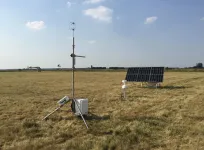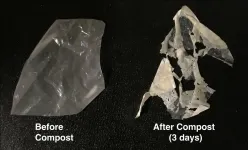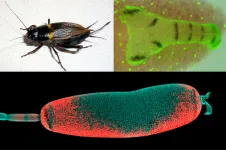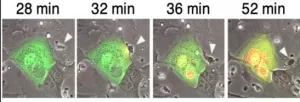Peatlands occupy just three per cent of the world's land surface area but store a similar amount of carbon to all terrestrial vegetation, as well as supporting unique biodiversity.
In their natural state, they can mitigate climate change by continuously removing CO2 from the atmosphere and storing it securely under waterlogged conditions for thousands of years.
But many peatland areas have been substantially modified by human activity, including drainage for agriculture and forest plantations. This results in the release, from drained peatlands, of the equivalent of around 1.5 billion tonnes of carbon dioxide (CO2) into the atmosphere each year - which equates to three per cent of all global greenhouse gas (GHG) emissions caused by human activities.
A team of scientists, led by the UK Centre for Ecology and Hydrology (UKCEH), estimated the potential reduction in emissions by restoring all global agricultural peatlands. However, because large populations rely on these areas for their livelihoods, it may not be realistic to expect all agricultural peatlands to be fully rewetted and returned to their natural condition in the near future.
The team therefore also analysed the impact of halving current drainage depths in croplands and grasslands on peat - which cover over 250,000km2 globally - and showed that this could still bring significant benefits for climate change mitigation. The study estimates this could cut emissions by around 500 million tonnes of CO2 a year, which equates to 1 per cent of all global GHG emissions caused by human activities.
A large proportion of the global greenhouse gases from peatlands are produced in Europe and Southeast Asia, with the total land area of many countries including the UK now a net source, not a sink, of GHGs due to emissions from degraded peat.
The study's authors say there is a growing recognition of the significance of peatlands for the global climate system, with efforts to curb emissions by conservation of undrained peatlands and rewetting of drained sites intensifying.
Professor Chris Evans of UKCEH, who led the research, says: "Widespread peatland degradation will need to be addressed if UK and other countries are to achieve their goal of net zero greenhouse gas emissions by 2050, as part of their contribution to the Paris climate agreement targets.
"Concerns over the economic and social consequences of rewetting agricultural peatlands have prevented large-scale restoration, but our study shows the development of locally appropriate mitigation measures could still deliver substantial reductions in emissions."
Professor Evans and his fellow authors recognise the practical challenges, for example controlling water levels and storage, as well as cultivating crops suited to the waterlogged conditions of peatlands, known as 'paludiculture'. Research into wetland-adapted crops is under way but does not yet provide commercially viable large-scale alternatives to conventional farming.
However, the scientists point out there is plenty of scope to partially rewet agricultural peatlands without severely affecting production because many sites are over-drained - sometimes to over two metres - and often when no crop is present.
In addition to increased emissions, drainage of peatlands causes land subsidence and soil compaction, which affects soil health and exposes low-lying areas to increasing flood risk. It also deprives rare wetland-adapted plants, insects and mammals of important habitats.
Professor Sue Page of the University of Leicester, a co-author of the study, says: "Our results present a challenge but also a great opportunity. Better water management in peatlands offers a potential 'win-win' - lower greenhouse gas emissions, improved soil health, extended agricultural lifetimes and reduced flood risk."
The scientists say potential reductions in greenhouse gases from halving the drainage depth in agricultural peatlands are likely to be greater than estimated, given they did not include changes in emissions of the GHG nitrous oxide (N2O) which, like levels of CO2, are also likely to be higher in deep-drained agricultural peatlands.
The study in Nature involved authors from UKCEH, the Swedish University of Agricultural Sciences, the University of Leeds, The James Hutton Institute, Bangor University, Durham University, Queen Mary University of London, University of Birmingham, University of Leicester, Rothamsted Research and Frankfurt University.
INFORMATION:
Notes to editors
Media enquiries
For interviews and information, please contact Simon Williams, Media Relations Officer at UKCEH, via simwil@ceh.ac.uk or +44 (0)7920 295384.
Paper information
Evans et al. 2021. Overriding importance of water table in the greenhouse gas balance of managed peatlands. Nature. DOI: 10.1038/s41586-021-03523-1
Methodology
For their study, the scientists used a current average water table depth of 90cm for croplands and 50cm for grasslands - halved to 45cm and 25cm respectively in their calculations. They based their global estimates of reductions in CO2 on emissions data from eddy covariance sites (which measure the exchange of gases between land and the atmosphere) on peatlands in the UK and across the world.
Peatland factfile
* Peatlands are wetland habitats that form where high rainfall or impeded drainage cause waterlogging, restricting oxygen supply and suppressing full decomposition of plants. While it takes 1,000 years for 1m of peat to build up, drainage means the land surface reduce by an average of 1cm to 2cm per year through subsidence due to peat oxidation.
* In the UK, total peatland covers around three million hectares - around 10 per cent of the country's total land surface - ¬and is divided into three types: Blanket bogs, raised bogs and fens. Some 80 per cent of this area is degraded, primarily due to drainage for agriculture and forestry, but also livestock grazing, managed burning, wildfires and extraction of peat for fuel, gardening and horticulture. Overall, net, emissions from UK peatlands are the equivalent of around 20 million tonnes of CO2 a year.
* In Europe, drainage for agriculture and forestry has been taking place for centuries. The UK's agricultural peatlands are mainly in the East Anglian Fens, Norfolk and Suffolk Broads, Somerset Levels, Lancashire and Cumbria Mosses, around the Humber Estuary, and in the Central Lowlands of Scotland. In Southeast Asia, up to three-quarters of peat swamp forests have been deforested and drained since 1990, primarily for agriculture, oil palm and pulpwood plantations.
* As well as resulting in increased greenhouse gas emissions, drying out peat soil makes the land more vulnerable to severe wildfires, which also produce CO2.
About the UK Centre for Ecology & Hydrology (UKCEH)
The UK Centre for Ecology & Hydrology is a centre for excellence in environmental science across water, land and air. Our 500 scientists work to understand the environment, how it sustains life and the human impact on it - so that together, people and nature can prosper.
We have a long history of investigating, monitoring and modelling environmental change, and our science makes a positive difference in the world. The issues our science addresses include: air pollution, biodiversity, biosecurity, chemical risks, extreme weather events, droughts, floods, greenhouse gas emissions, land use, soil health, sustainable agriculture, sustainable ecosystems, sustainable macronutrient use, and water resources management.
The UK Centre for Ecology & Hydrology is a strategic delivery partner for the Natural Environment Research Council, part of UK Research and Innovation.
http://www.ceh.ac.uk / Twitter: @UK_CEH







